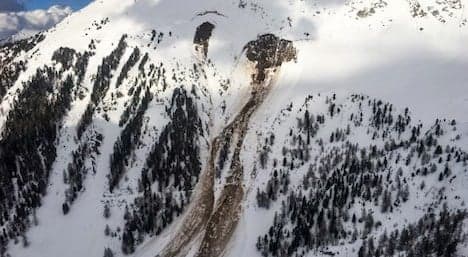Experts confirm Swiss winter broke records for snowfall

Following three years with little snow, the Swiss winter of 2017-18 brought exceptional quantities of the white stuff – but only in the mountains.
Record snowfall, avalanches and horror storms were all part of the picture from December right up to the end of April, when 10 people died in three separate bad weather incidents.
Read also: Horror storm in Swiss Alps claims tenth victim
The Swiss Institute for Snow and Avalanche Research SLF/WSL said on Thursday that overall it had been one of the longest and whitest winters for 30 years at elevations above 1,500 metres.
Hiver 2017/18 - Quantités exceptionnelles de #neige et très fort danger d’#avalanche. Rétrospective de l'#SLF: https://t.co/lFl0qI6jbf pic.twitter.com/uQdBufPs37
— WSL Umweltforschung (@WSL_research) May 3, 2018
In November, December and January it snowed intensively. From the end of December until the end of January between 2.5 and five metres of snow fell at locations above 2,000 metres.
Most snow fell in the canton of Valais with the ski resorts of Saas-Fee and Zermatt both recording their highest snowfall for 70 years in January.
The extreme weather resulted in Zermatt and several other villages being cut off from the outside world for days on end.
Read also: 13,000 tourists stranded in Zermatt
It was a completely different story in the plains, SLF/WSL said, with half the usual amount of snowfall below 1,000 metres.
January was extremely warm – the warmest since recordings began in 1864 – and any precipitation fell as rain at lower levels.
The risk of avalanches reached its peak in January with the avalanche research centre issuing its highest risk warning for an extended area on January 22nd – the first time it had done so since 1999.
Valais and Graubünden in particular experienced major avalanches during this month.
By the end of April over 250 avalanches had been recorded that resulted in damage, the institute said.
And there was a heavy human toll: 26 people died in 19 avalanches.
The long-term average is 21 avalanche deaths in a winter.
All those who died were engaged in winter sports.
Comments
See Also
Record snowfall, avalanches and horror storms were all part of the picture from December right up to the end of April, when 10 people died in three separate bad weather incidents.
Read also: Horror storm in Swiss Alps claims tenth victim
The Swiss Institute for Snow and Avalanche Research SLF/WSL said on Thursday that overall it had been one of the longest and whitest winters for 30 years at elevations above 1,500 metres.
Hiver 2017/18 - Quantités exceptionnelles de #neige et très fort danger d’#avalanche. Rétrospective de l'#SLF: https://t.co/lFl0qI6jbf pic.twitter.com/uQdBufPs37
— WSL Umweltforschung (@WSL_research) May 3, 2018
In November, December and January it snowed intensively. From the end of December until the end of January between 2.5 and five metres of snow fell at locations above 2,000 metres.
Most snow fell in the canton of Valais with the ski resorts of Saas-Fee and Zermatt both recording their highest snowfall for 70 years in January.
The extreme weather resulted in Zermatt and several other villages being cut off from the outside world for days on end.
Read also: 13,000 tourists stranded in Zermatt
It was a completely different story in the plains, SLF/WSL said, with half the usual amount of snowfall below 1,000 metres.
January was extremely warm – the warmest since recordings began in 1864 – and any precipitation fell as rain at lower levels.
The risk of avalanches reached its peak in January with the avalanche research centre issuing its highest risk warning for an extended area on January 22nd – the first time it had done so since 1999.
Valais and Graubünden in particular experienced major avalanches during this month.
By the end of April over 250 avalanches had been recorded that resulted in damage, the institute said.
And there was a heavy human toll: 26 people died in 19 avalanches.
The long-term average is 21 avalanche deaths in a winter.
All those who died were engaged in winter sports.
Join the conversation in our comments section below. Share your own views and experience and if you have a question or suggestion for our journalists then email us at [email protected].
Please keep comments civil, constructive and on topic – and make sure to read our terms of use before getting involved.
Please log in here to leave a comment.